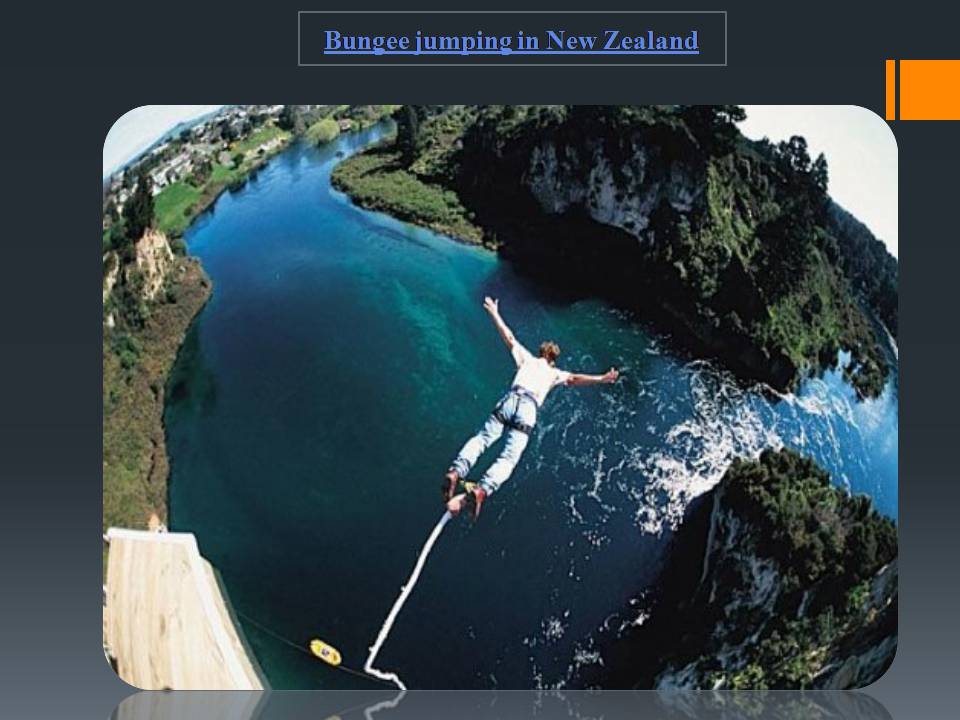- Головна
- Готові шкільні презентації
- Презентація на тему «New Zeland» (варіант 2)
Презентація на тему «New Zeland» (варіант 2)
185
Слайд #1
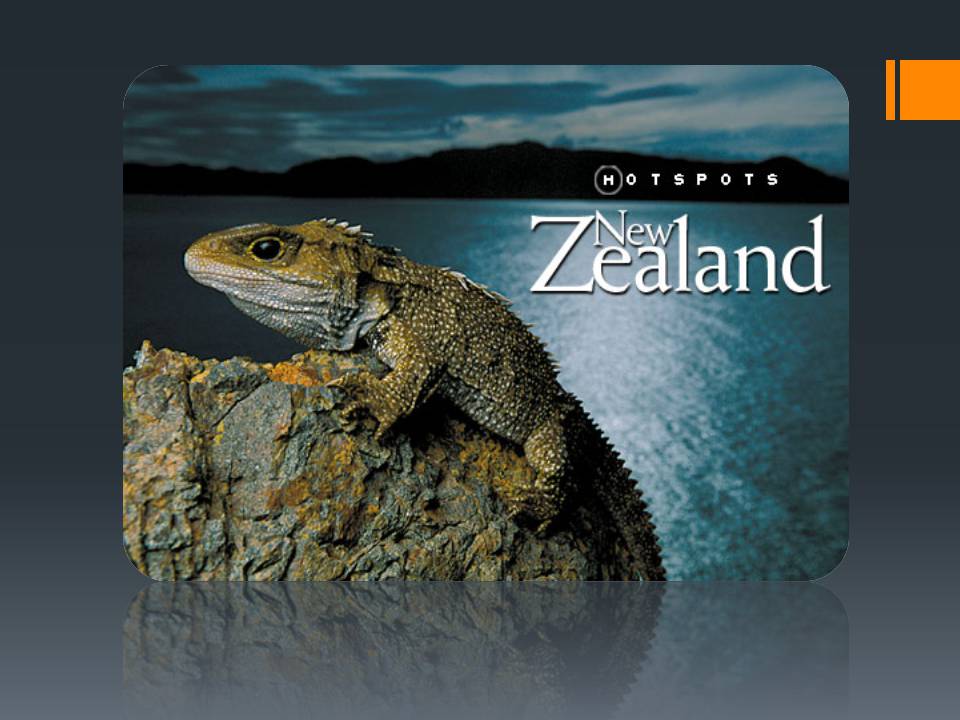
Слайд #2
Fact File
Official namettNew Zealand (English); Aoteraoa (Maori)
Capital cityttWellington
Largest citiesttAuckland, Christchurch, Dunedin
Total areatt268, 680 sq km
Population tt4,116, 000 people
Main religionsttChristian, Catholic
Major ethnic groupstEuropeans, Maori, Pacific Islanders, Asian
Consist ofttNorth Island, South Island, Stewart Island,
Chatman Islands and minor islands
Currency ttNew Zealand Dollar (NZ$)
Official languagetEnglish, Maori
Form of governmenttparliamentary democratic monarchy
Natural resourcestland (for farming, dairy farming, cattle ttttbreeding), forests
Flag tttthe New Zealand Flag
Internet TLD (top-level domain) tt.nz
Official namettNew Zealand (English); Aoteraoa (Maori)
Capital cityttWellington
Largest citiesttAuckland, Christchurch, Dunedin
Total areatt268, 680 sq km
Population tt4,116, 000 people
Main religionsttChristian, Catholic
Major ethnic groupstEuropeans, Maori, Pacific Islanders, Asian
Consist ofttNorth Island, South Island, Stewart Island,
Chatman Islands and minor islands
Currency ttNew Zealand Dollar (NZ$)
Official languagetEnglish, Maori
Form of governmenttparliamentary democratic monarchy
Natural resourcestland (for farming, dairy farming, cattle ttttbreeding), forests
Flag tttthe New Zealand Flag
Internet TLD (top-level domain) tt.nz
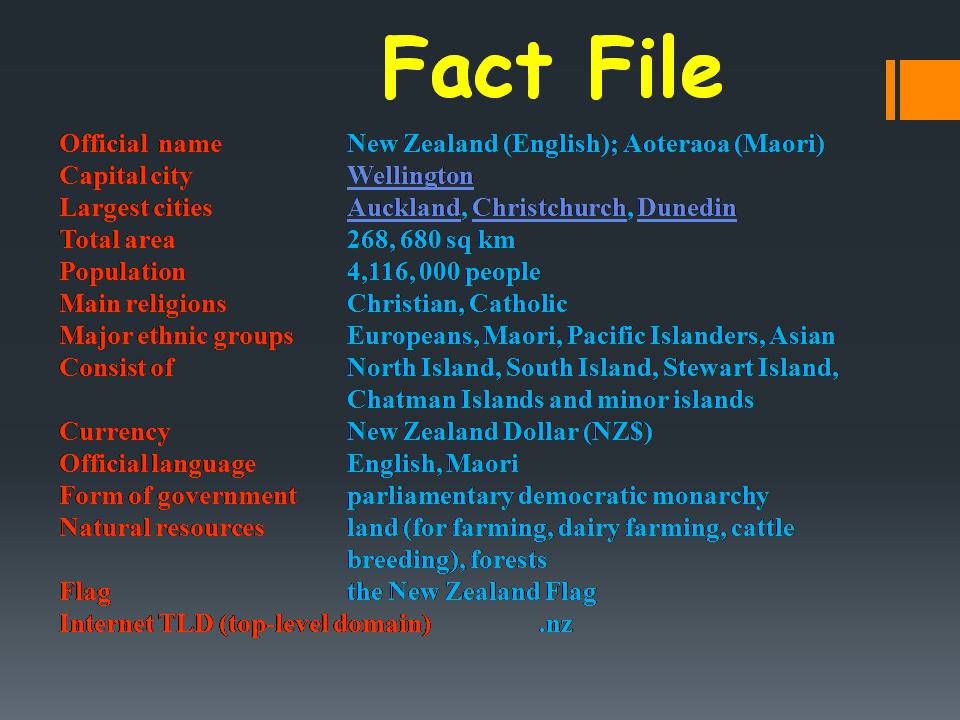
Слайд #3
The map of New Zealand
New Zealand lies between the Equator and the South Pole in the southern Pacific Ocean, near the eastern coast of Australia.
New Zealand is an island country with a total area of 268, 680 sq km.
It has no land boundaries. Australia is New Zealander's nearest western neighbour. These two countries are separated from each other by the Tasman Sea.
New Zealand lies between the Equator and the South Pole in the southern Pacific Ocean, near the eastern coast of Australia.
New Zealand is an island country with a total area of 268, 680 sq km.
It has no land boundaries. Australia is New Zealander's nearest western neighbour. These two countries are separated from each other by the Tasman Sea.
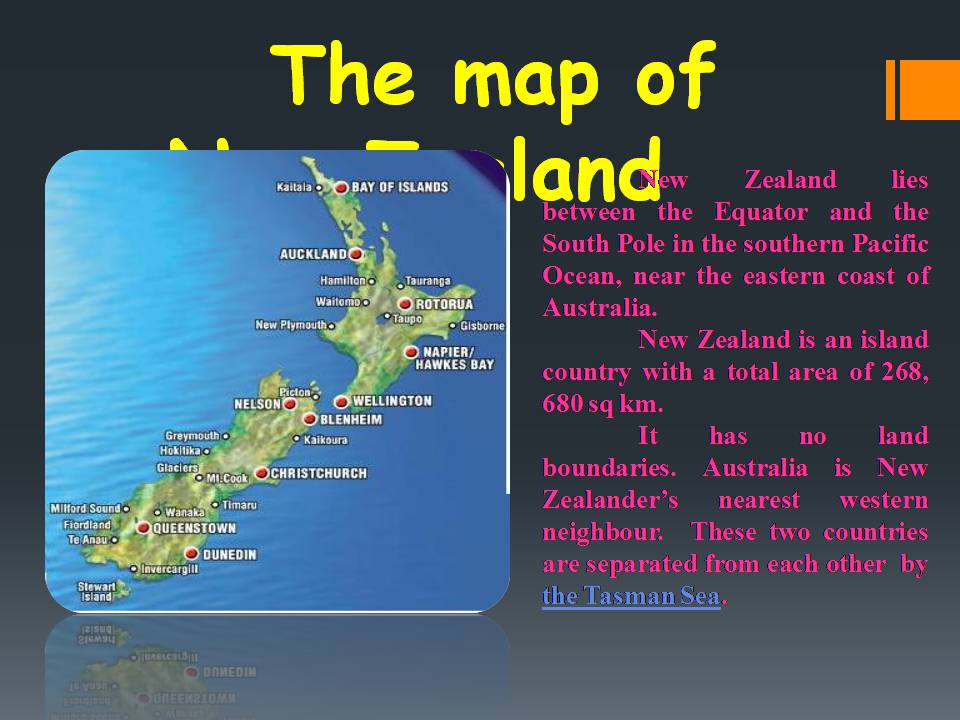
Слайд #4
The geographical peculiarities
New Zealand is made up of three main islands – the North Sea, the South Sea and the Stewart Island. The South Island is separated from the North island by Cook Strait.
The Stewart Island
Cook Strait
The North Sea
The South Sea
New Zealand is made up of three main islands – the North Sea, the South Sea and the Stewart Island. The South Island is separated from the North island by Cook Strait.
The Stewart Island
Cook Strait
The North Sea
The South Sea
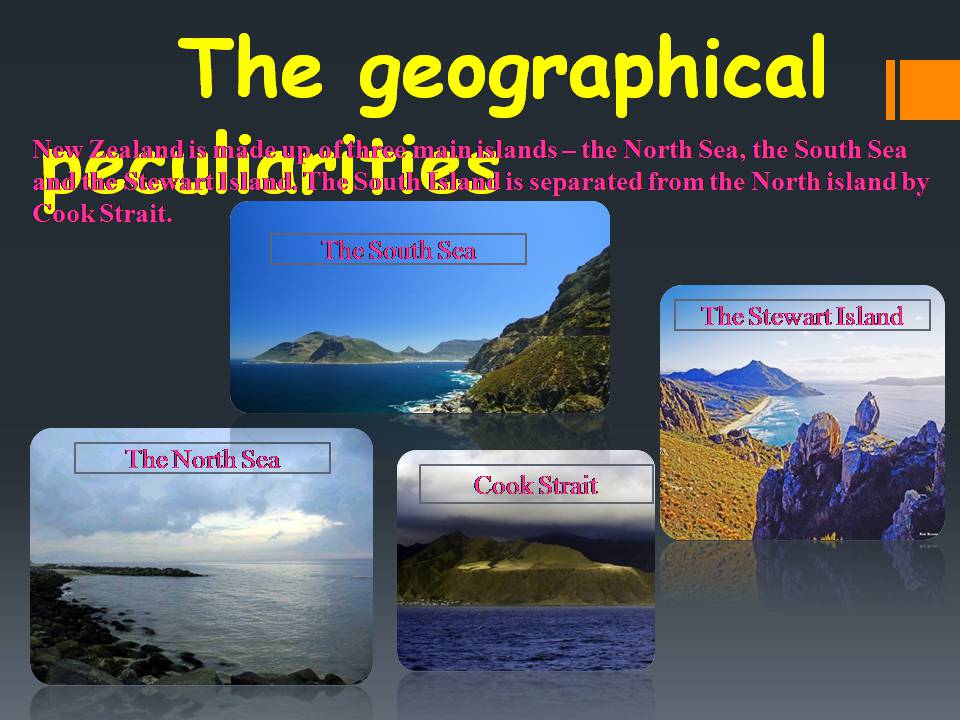
Слайд #5
The geographical peculiarities
There are also such smaller offshore islands as the Chatham Islands, Campbell Islands, the Antipode Islands, the Bounty Islands and the Auckland Islands.
The Antipodes Islands
The Kermadec Islands
Chatham Island
The Bounty Island
Campbell Island
There are also such smaller offshore islands as the Chatham Islands, Campbell Islands, the Antipode Islands, the Bounty Islands and the Auckland Islands.
The Antipodes Islands
The Kermadec Islands
Chatham Island
The Bounty Island
Campbell Island
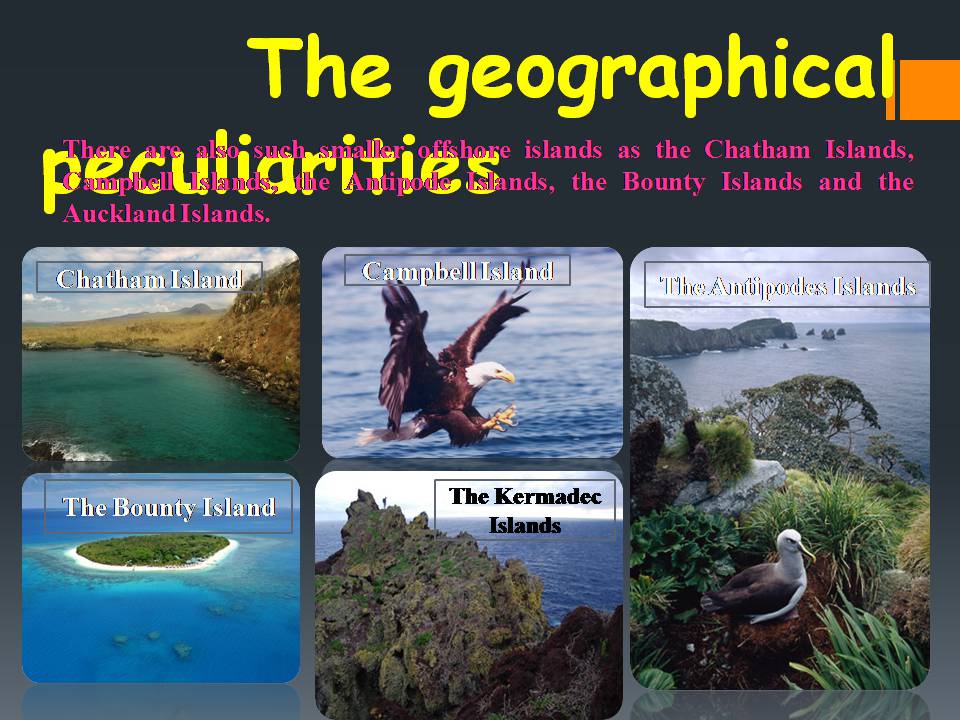
Слайд #6
It's interesting to know…
…New Zealand is 12 hours ahead of Greenwich Mean Time (GMT). So, it is one of the first places in the world to see the new day.
…The Maori people call New Zealand Aotearoa, which is usually translated into English as “The Land of the Long White Cloud”.
…New Zealand is also called “Godzone”, “Pig Isles”, “Shaky Isles”, “Quaky Isles”, “Maoriland” and “Kiwiland”
An interesting historical fact…
The name “New Zealand” came from Dutch cartographers, who called the islands “Nova Zeelandia”, after the Dutch province of Zeeland. British explorer James Cook adapted the name to the English language and the name became New Zealand.
…New Zealand is 12 hours ahead of Greenwich Mean Time (GMT). So, it is one of the first places in the world to see the new day.
…The Maori people call New Zealand Aotearoa, which is usually translated into English as “The Land of the Long White Cloud”.
…New Zealand is also called “Godzone”, “Pig Isles”, “Shaky Isles”, “Quaky Isles”, “Maoriland” and “Kiwiland”
An interesting historical fact…
The name “New Zealand” came from Dutch cartographers, who called the islands “Nova Zeelandia”, after the Dutch province of Zeeland. British explorer James Cook adapted the name to the English language and the name became New Zealand.
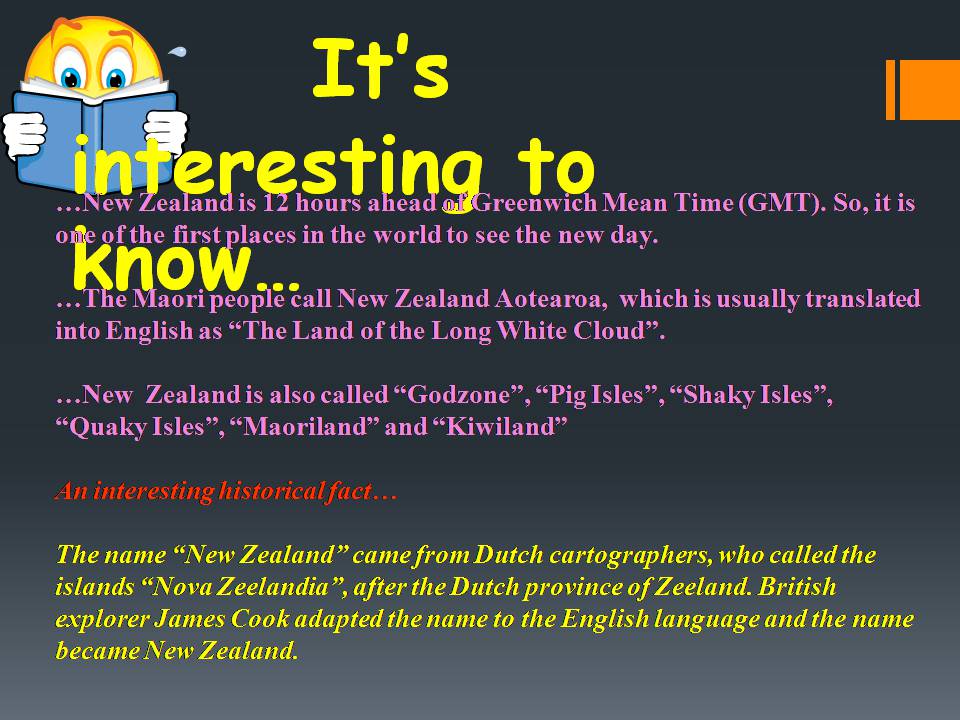
Слайд #7
The geographical peculiarities
Though the country is so small there are so many beautiful things that attract attention - volcanoes, subtropical rainforests, geysers, fiords, beaches, glaciers and high mountain peaks.
New Zealand lies on the plates that make geological movements. Volcanic action still continues on the islands. Earthquakes are frequent here though they are not so damaging.
The North Island has a number of large active volcanoes, among them is Ruapehu. The last eruptions were here in 1995 and 1996.
Ruapehu
Though the country is so small there are so many beautiful things that attract attention - volcanoes, subtropical rainforests, geysers, fiords, beaches, glaciers and high mountain peaks.
New Zealand lies on the plates that make geological movements. Volcanic action still continues on the islands. Earthquakes are frequent here though they are not so damaging.
The North Island has a number of large active volcanoes, among them is Ruapehu. The last eruptions were here in 1995 and 1996.
Ruapehu
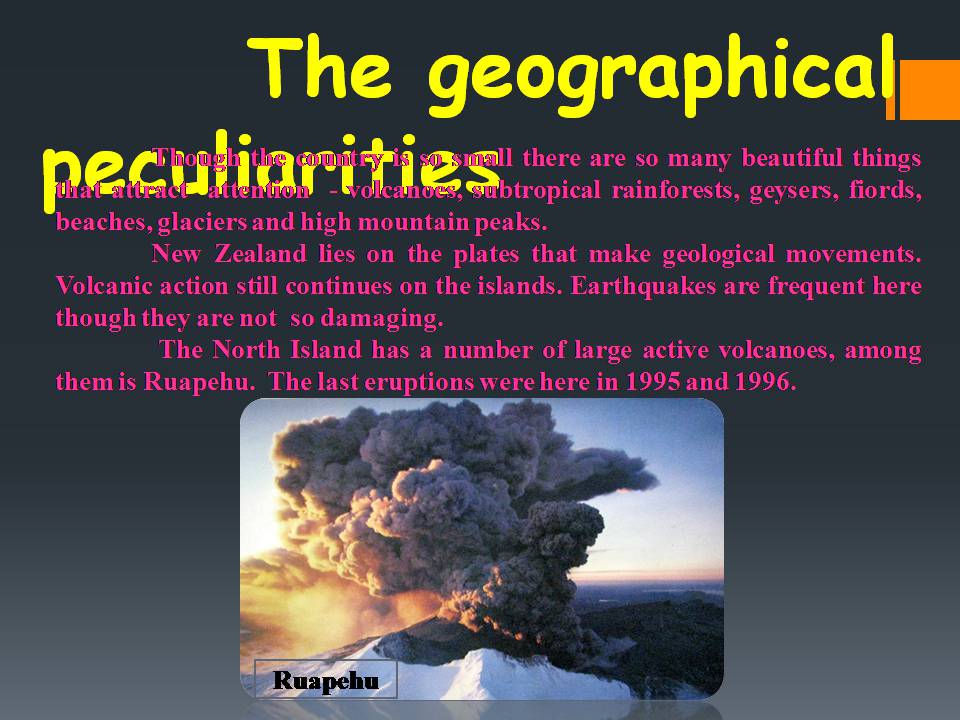
Слайд #8
Flora and fauna of New Zealand
Flora in New Zealand is very rich. There are about 2,000 species where 1,500 are endemic (which are only found in this country). It also has some of the oldest trees.
Fauna in this country is also special. Long time ago, without enemies, some birds lost their ability to fly, and some insects became gigantic.
It's interesting to know…
Before Europeans came to New Zealand there were no predatory animals at all. This was so good for many flightless birds. All wild mammals living in New Zealand at present were imported.
Flora in New Zealand is very rich. There are about 2,000 species where 1,500 are endemic (which are only found in this country). It also has some of the oldest trees.
Fauna in this country is also special. Long time ago, without enemies, some birds lost their ability to fly, and some insects became gigantic.
It's interesting to know…
Before Europeans came to New Zealand there were no predatory animals at all. This was so good for many flightless birds. All wild mammals living in New Zealand at present were imported.
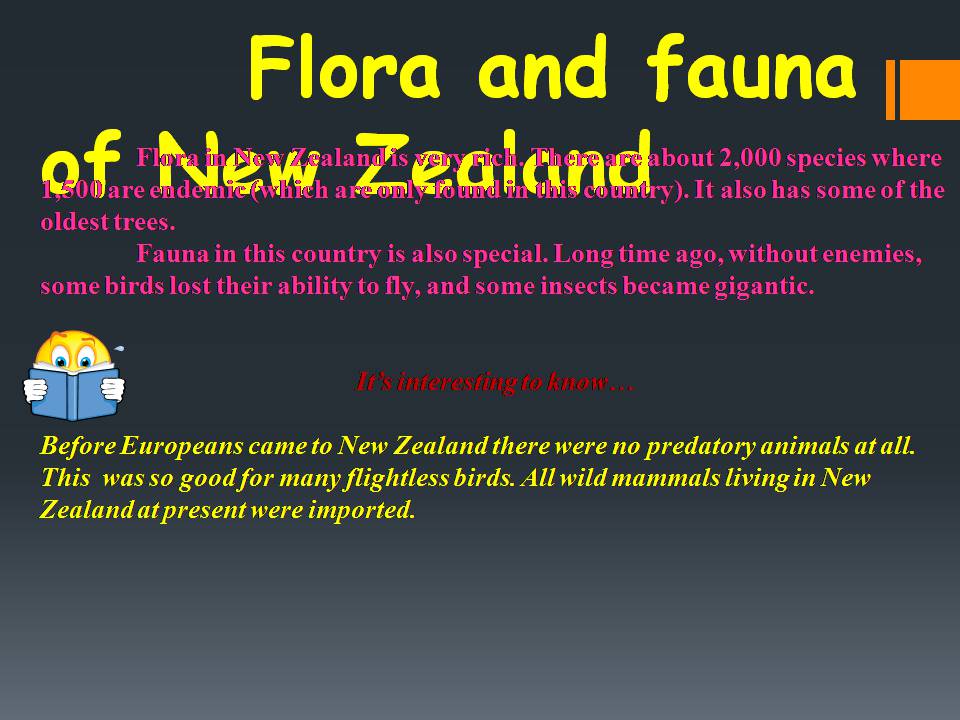
Слайд #9
Flora and fauna of New Zealand
Many of New Zealand's native animals are found nowhere else in the world:
the kakapo – the world's largest flightless parrot
the tuatara – the oldest living reptile Tuataras live for 300 years. They can be
traced back 190 million years to the Mesozoic era
kakapo
tuatara
Many of New Zealand's native animals are found nowhere else in the world:
the kakapo – the world's largest flightless parrot
the tuatara – the oldest living reptile Tuataras live for 300 years. They can be
traced back 190 million years to the Mesozoic era
kakapo
tuatara
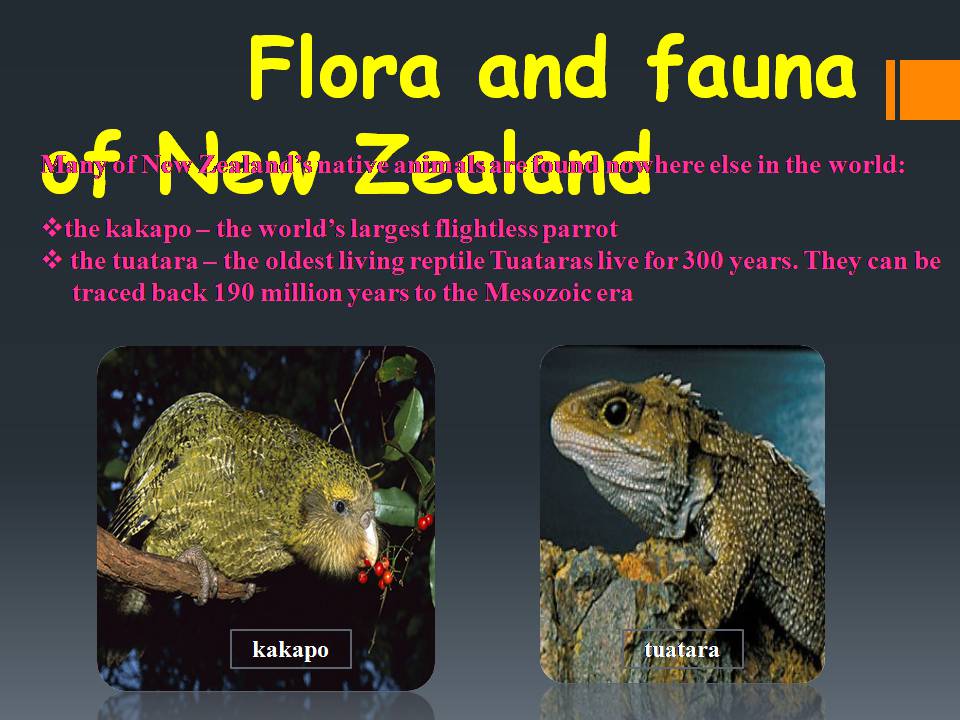
Слайд #10
Flora and fauna of New Zealand
the biggest earthworms in the world
the smallest bats in the world – the only native land mammals in New
Zealand
the weta – the heaviest insect in the world (70 gm and 20 cm long)
the weta
New Zealand bat
the biggest earthworms in the world
the smallest bats in the world – the only native land mammals in New
Zealand
the weta – the heaviest insect in the world (70 gm and 20 cm long)
the weta
New Zealand bat
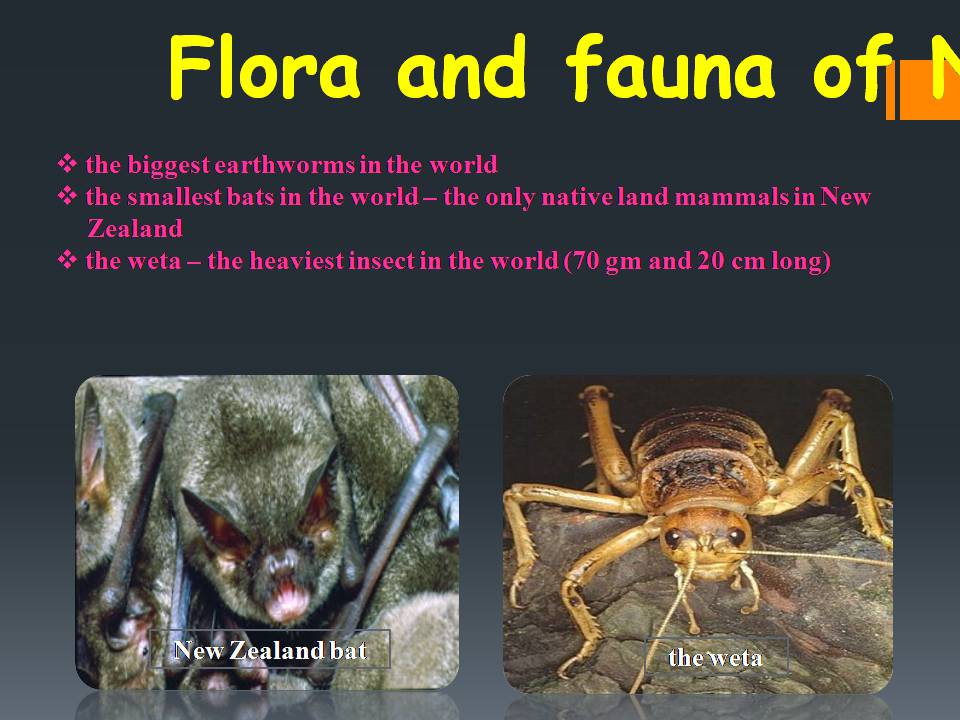
Слайд #11
Rivers and mountains
New Zealand is a very mountainous country. About one third of the islands is covered with mountains. The Southern Alps run along the western coast of the South Island and are the highest in New Zealand. Mount Cook is the highest mountain there (3, 050 metres above the sea level).
the Southern Alps
Mount Cook
New Zealand is a very mountainous country. About one third of the islands is covered with mountains. The Southern Alps run along the western coast of the South Island and are the highest in New Zealand. Mount Cook is the highest mountain there (3, 050 metres above the sea level).
the Southern Alps
Mount Cook
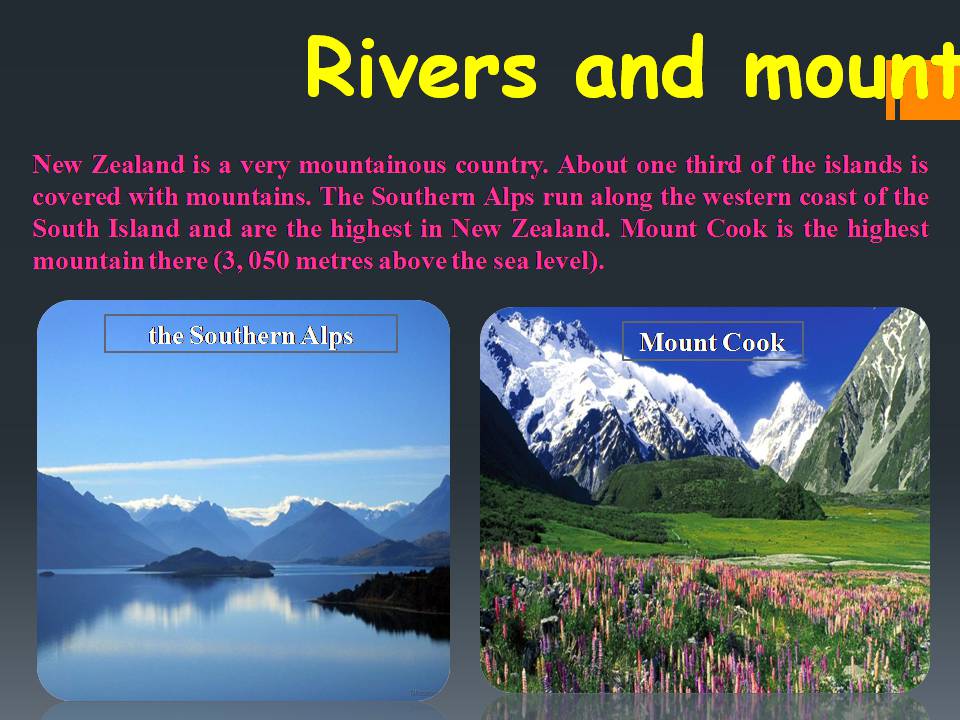
Слайд #12
Rivers and mountains
It's interesting to know…
Sometimes New Zealanders say that the North Island means “beaches” and the South Island means “mountains”
New Zealand's rivers are mainly short and swift. The longest river is the Waikato. There are many lakes on both islands as well. The North Island's volcanic interior contains New Zealand's largest lake. Its name is lake Taupo.
Waikato
Taupo
It's interesting to know…
Sometimes New Zealanders say that the North Island means “beaches” and the South Island means “mountains”
New Zealand's rivers are mainly short and swift. The longest river is the Waikato. There are many lakes on both islands as well. The North Island's volcanic interior contains New Zealand's largest lake. Its name is lake Taupo.
Waikato
Taupo
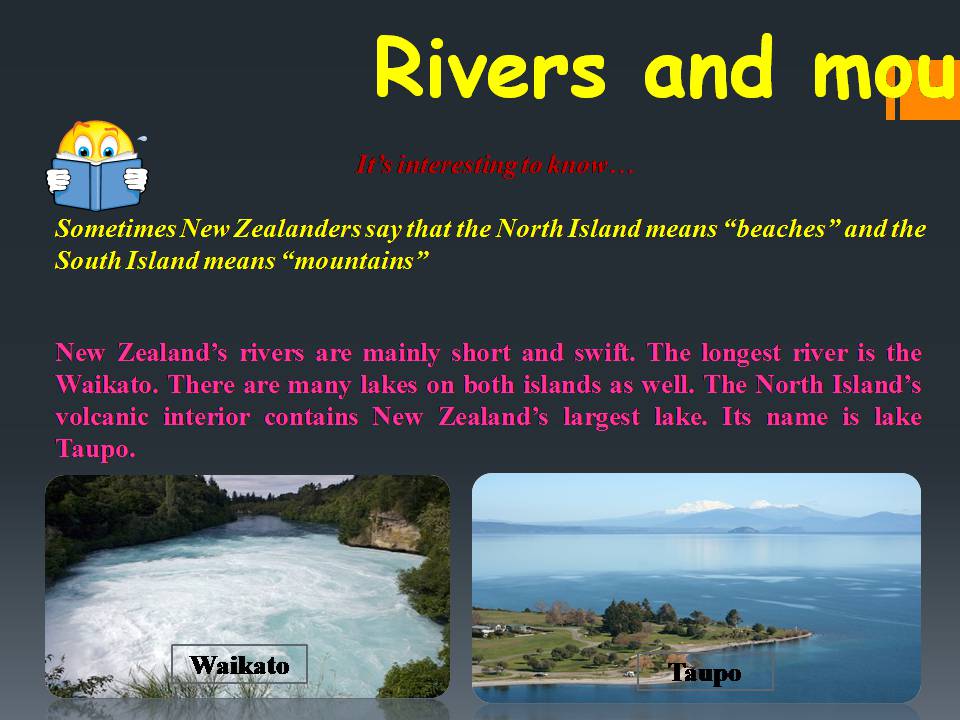
Слайд #13
Climate
New Zealand is known for its maritime climate which is quite good during the whole year. It is moist, temperate and is affected by latitude and the proximity of the ocean.
Climate of this country has no extremes and no wide range of temperatures. The difference of winter and summer temperatures is about 10 degrees. That is why New Zealand is very attractive for tourists. Seasons here are reverse of the Northern Hemisphere like in Australia.
Because of New Zealand's wet and mild climate many inhabitants of the country are busy with farming and dairy goods production.
There are heavy rainfalls in New Zealand all year round which is very good for cattle –farming, sheep- farming, growing fruit, vegetables and flowers.
New Zealand is known for its maritime climate which is quite good during the whole year. It is moist, temperate and is affected by latitude and the proximity of the ocean.
Climate of this country has no extremes and no wide range of temperatures. The difference of winter and summer temperatures is about 10 degrees. That is why New Zealand is very attractive for tourists. Seasons here are reverse of the Northern Hemisphere like in Australia.
Because of New Zealand's wet and mild climate many inhabitants of the country are busy with farming and dairy goods production.
There are heavy rainfalls in New Zealand all year round which is very good for cattle –farming, sheep- farming, growing fruit, vegetables and flowers.
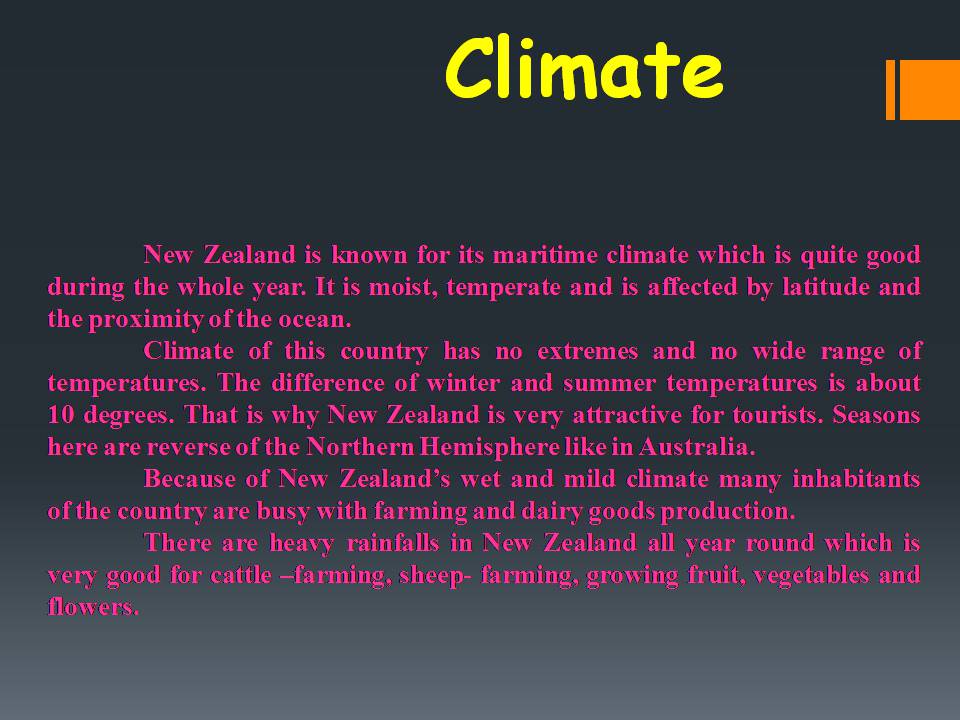
Слайд #14
Big cities
More than 85 per cent of the population of New Zealand lives in urban areas. The principal country cities are Wellington (the capital), Auckland, Christchurch, Dunedin, Hamilton, Palmerston North, Hutt City, Invercargill. Early in the 20th century the first four mentioned cities were almost equal in importance but then they started to develop rapidly except for Dunedin.
Wellington is the capital of the country, its second largest city, the main port, the centre of finance and commerce and a sit of the government. It is situated on the southern coast of the North Island.
The population of greater Wellington is about 350,000 people. Wellington has been the capital of the country since 1865.
More than 85 per cent of the population of New Zealand lives in urban areas. The principal country cities are Wellington (the capital), Auckland, Christchurch, Dunedin, Hamilton, Palmerston North, Hutt City, Invercargill. Early in the 20th century the first four mentioned cities were almost equal in importance but then they started to develop rapidly except for Dunedin.
Wellington is the capital of the country, its second largest city, the main port, the centre of finance and commerce and a sit of the government. It is situated on the southern coast of the North Island.
The population of greater Wellington is about 350,000 people. Wellington has been the capital of the country since 1865.
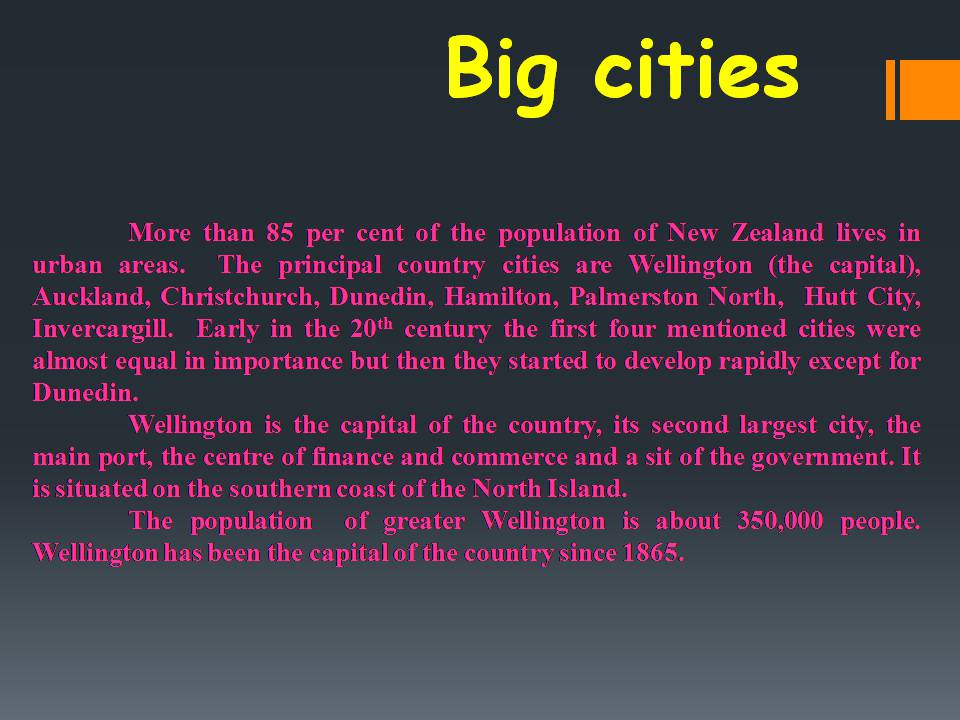
Слайд #15
Big cities
An interesting historical fact…
Wellington's nickname is “the windy city”. The first European name of the city was “Port Nicholson” named after a captain of the British navy who in 1839 bought the land from the local Maori tribe in exchange for blankets. In 1840 the first settlers arrived from Britain and called this settlement “Britannia”. And “Britannia” later became “Wellington”.
Auckland is New Zealand's largest city and its former capital. It has a population of over a million people. Auckland was first established as the capital of the British colonial government.
Despite the fact that Auckland is much larger than Wellington it is geographically less central. So, this was the major deciding factor for transferring the capital to Wellington.
Christchurch and Dunedin are two main cities of the South Island. These cities are very much like British ones because of their atmosphere.
An interesting historical fact…
Wellington's nickname is “the windy city”. The first European name of the city was “Port Nicholson” named after a captain of the British navy who in 1839 bought the land from the local Maori tribe in exchange for blankets. In 1840 the first settlers arrived from Britain and called this settlement “Britannia”. And “Britannia” later became “Wellington”.
Auckland is New Zealand's largest city and its former capital. It has a population of over a million people. Auckland was first established as the capital of the British colonial government.
Despite the fact that Auckland is much larger than Wellington it is geographically less central. So, this was the major deciding factor for transferring the capital to Wellington.
Christchurch and Dunedin are two main cities of the South Island. These cities are very much like British ones because of their atmosphere.
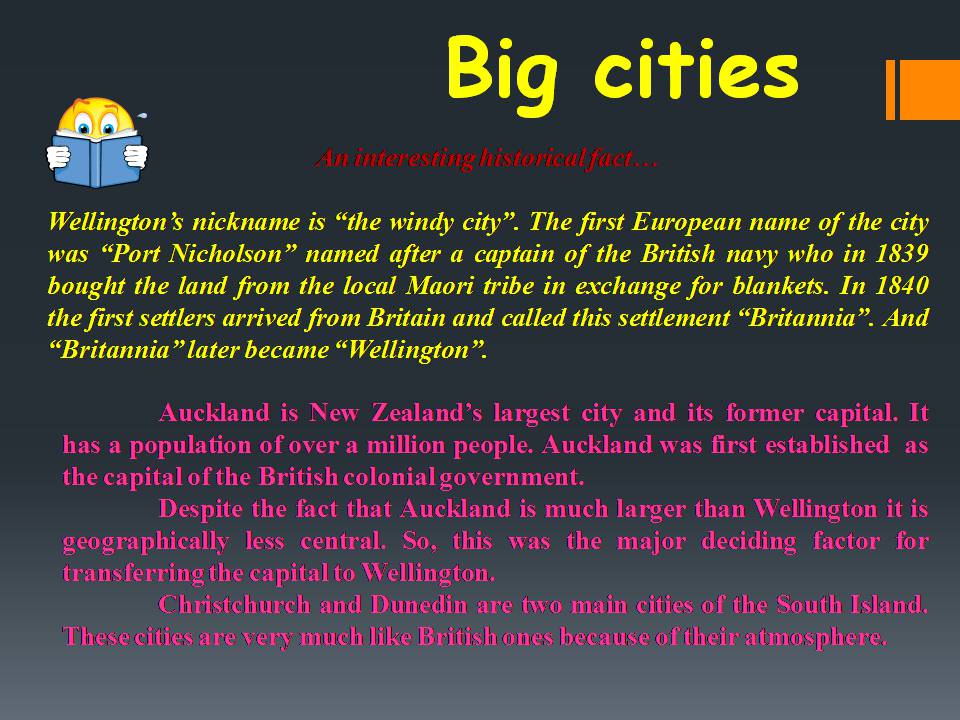
Слайд #16
The population of the country
The population of New Zealand is over four million people. It is unevenly distributed. The main part of the population lives on the North Island which is obviously closer to the Equator and warmer. About 50 per cent of the population lives in four cities of Auckland, Wellington, Christchurch and Dunedin.
It's interesting to know…
Arthur Lydiard, a New Zealander, invented jogging – the method of building physical fitness by increasing stamina gradually through running slowly. Bungee jumping was also invented in New Zealand.
The population of New Zealand is over four million people. It is unevenly distributed. The main part of the population lives on the North Island which is obviously closer to the Equator and warmer. About 50 per cent of the population lives in four cities of Auckland, Wellington, Christchurch and Dunedin.
It's interesting to know…
Arthur Lydiard, a New Zealander, invented jogging – the method of building physical fitness by increasing stamina gradually through running slowly. Bungee jumping was also invented in New Zealand.
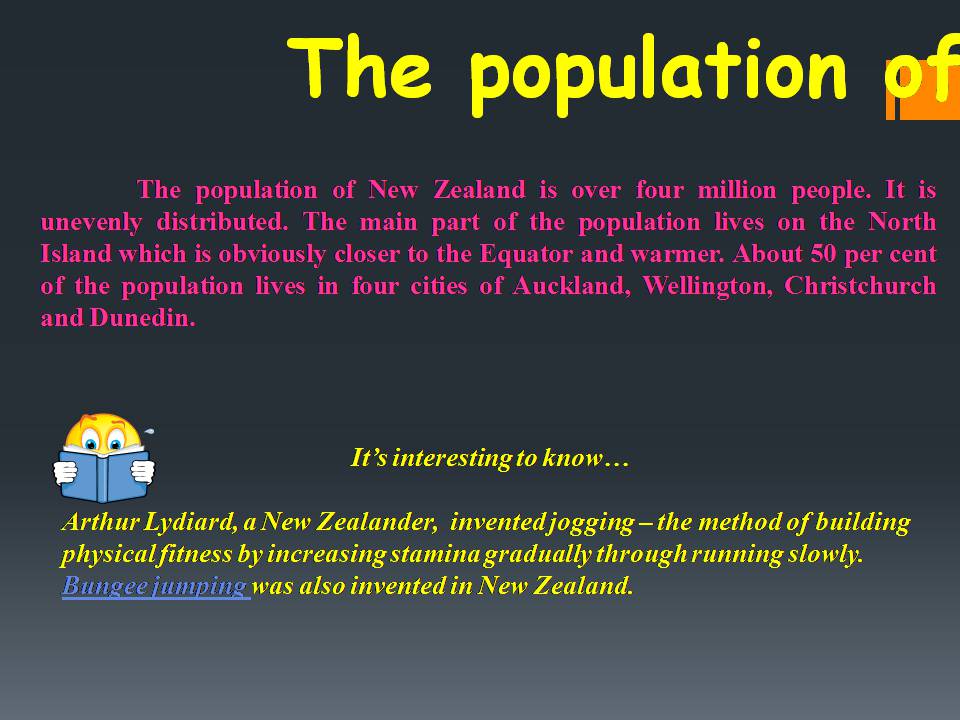
Слайд #17
The population of the country
Almost 70 per cent of the population is people of European (mainly British) background. And about eight per cent is the Maori, New Zealand's indigenous inhabitants or Aborigines. There are also small minorities of Pacific Islanders and Asians.
The Maori originate from a Polynesian people from south-east Asia. The exact date of Polynesian settlement on islands of New Zealand is unknown. It could be between 950-1130 AD.
The Maori tribes had lived on the islands of New Zealand for hundreds of years before the white people came there.
Abel Tasman was the first European explorer who saw New Zealand in 1642. But captain James Cook, an Englishman, was the first who first set foot on New Zealand's soil in 1769. After his voyages Europeans began to come frequently.
Almost 70 per cent of the population is people of European (mainly British) background. And about eight per cent is the Maori, New Zealand's indigenous inhabitants or Aborigines. There are also small minorities of Pacific Islanders and Asians.
The Maori originate from a Polynesian people from south-east Asia. The exact date of Polynesian settlement on islands of New Zealand is unknown. It could be between 950-1130 AD.
The Maori tribes had lived on the islands of New Zealand for hundreds of years before the white people came there.
Abel Tasman was the first European explorer who saw New Zealand in 1642. But captain James Cook, an Englishman, was the first who first set foot on New Zealand's soil in 1769. After his voyages Europeans began to come frequently.
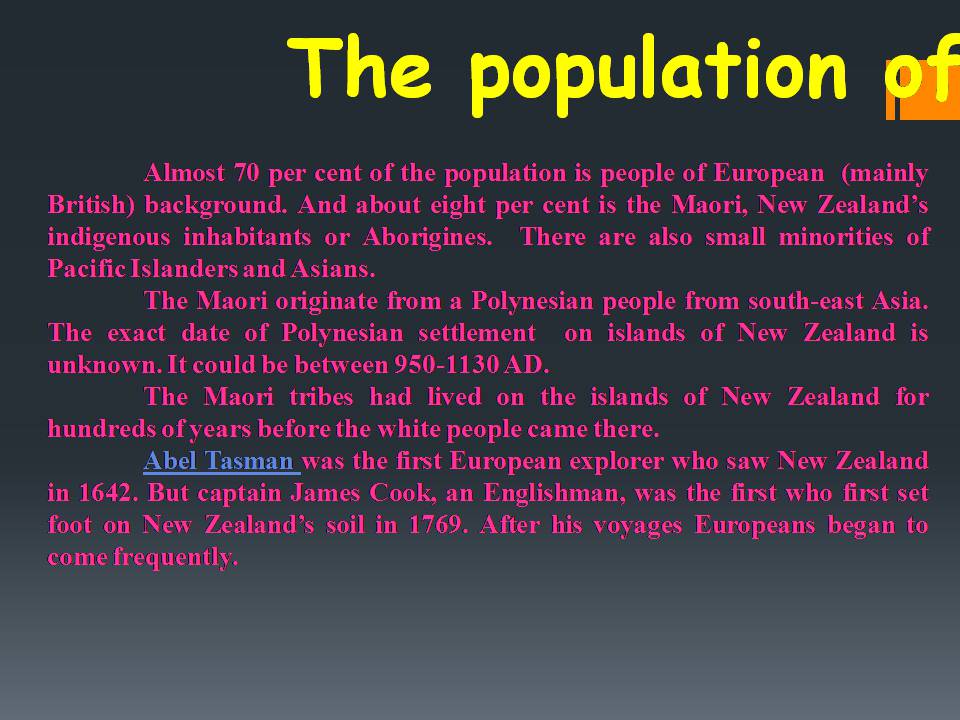
Слайд #18
The population of the country
An interesting historical fact…
Before Europeans came to the island, the tribes of Maori did not have the name for themselves. They adopted the name “Maori” meaning “normal” to distinguish themselves from Europeans.
The tribes of Maori are well-known all over the world. The Maori are famous for their folk-songs and wood-work. They are often called “Vikings of Sunrise”.
An interesting historical fact…
Before Europeans came to the island, the tribes of Maori did not have the name for themselves. They adopted the name “Maori” meaning “normal” to distinguish themselves from Europeans.
The tribes of Maori are well-known all over the world. The Maori are famous for their folk-songs and wood-work. They are often called “Vikings of Sunrise”.
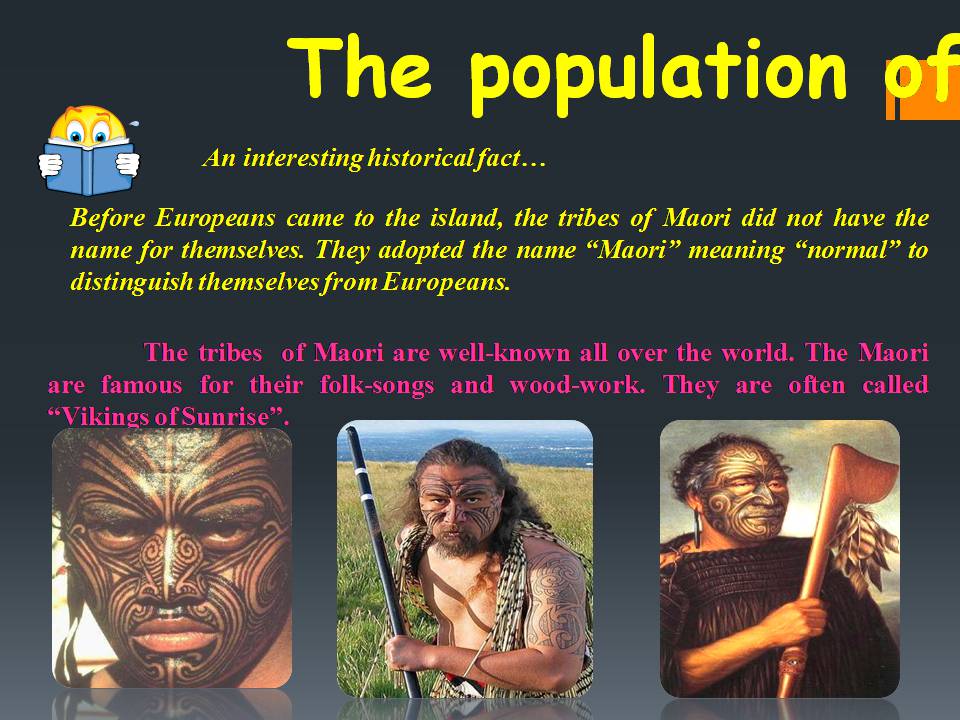
Слайд #19
The population of the country
In the 19th century there was a struggle between the Maori people and the British colonies. It was a series of the Maori Wars. Many of the Maori were killed and English settlers took their lands.
Both English and Maori are official languages. English is more widely spoken, though the Maori language is now coming back thanks to the revival of their native language Maoritanga and Maori culture.
In the 19th century there was a struggle between the Maori people and the British colonies. It was a series of the Maori Wars. Many of the Maori were killed and English settlers took their lands.
Both English and Maori are official languages. English is more widely spoken, though the Maori language is now coming back thanks to the revival of their native language Maoritanga and Maori culture.
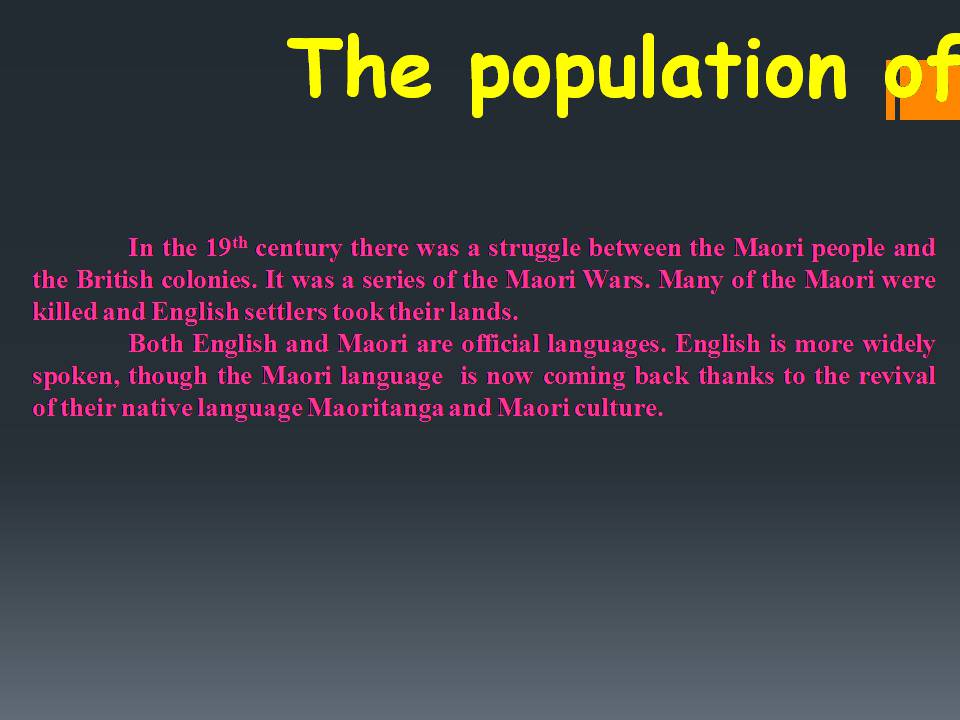
Слайд #20
The symbols of New Zealand
The symbol of New Zealand is the kiwi – a flightless bird, native to this country.
Kiwi has no tttt tail, almost no wings and is about the size tttt of a large hen. No other bird lays eggstttt so large in proportion to its size: the egg is tttt about one fifth of its own weigh. It means tttt that in many ways the kiwi does not look tttt like an ordinary bird. It is rare and very tttt much protected.
It's interesting to know:
The Kiwi as an emblemtttt first appeared in the late 19th century. tttt During World War I the name “kiwi” was tttt used for New Zealand soldiers.
The symbol of New Zealand is the kiwi – a flightless bird, native to this country.
Kiwi has no tttt tail, almost no wings and is about the size tttt of a large hen. No other bird lays eggstttt so large in proportion to its size: the egg is tttt about one fifth of its own weigh. It means tttt that in many ways the kiwi does not look tttt like an ordinary bird. It is rare and very tttt much protected.
It's interesting to know:
The Kiwi as an emblemtttt first appeared in the late 19th century. tttt During World War I the name “kiwi” was tttt used for New Zealand soldiers.
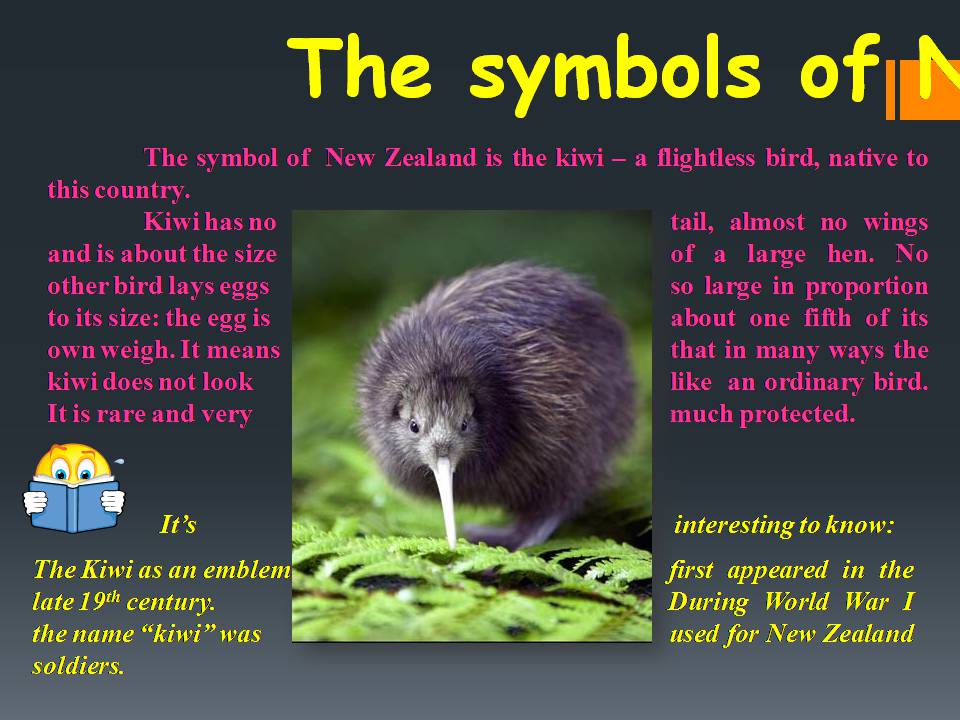
Слайд #21
The symbols of New Zealand
Today, New Zealanders overseas (and at home) are called “Kiwis”. The Kiwi is closely associated with the Armed Forces. The green fruit with the brown skin that we call “kiwi” is known as “kiwifruit”.
They often call small children “Kiwis”. In elementary school there are such posters with the words: “Be a tidy kiwi!”
The bird is now used in the coat of arms, crests and badges of many New Zealand cities, clubs and organisations.
Today, New Zealanders overseas (and at home) are called “Kiwis”. The Kiwi is closely associated with the Armed Forces. The green fruit with the brown skin that we call “kiwi” is known as “kiwifruit”.
They often call small children “Kiwis”. In elementary school there are such posters with the words: “Be a tidy kiwi!”
The bird is now used in the coat of arms, crests and badges of many New Zealand cities, clubs and organisations.
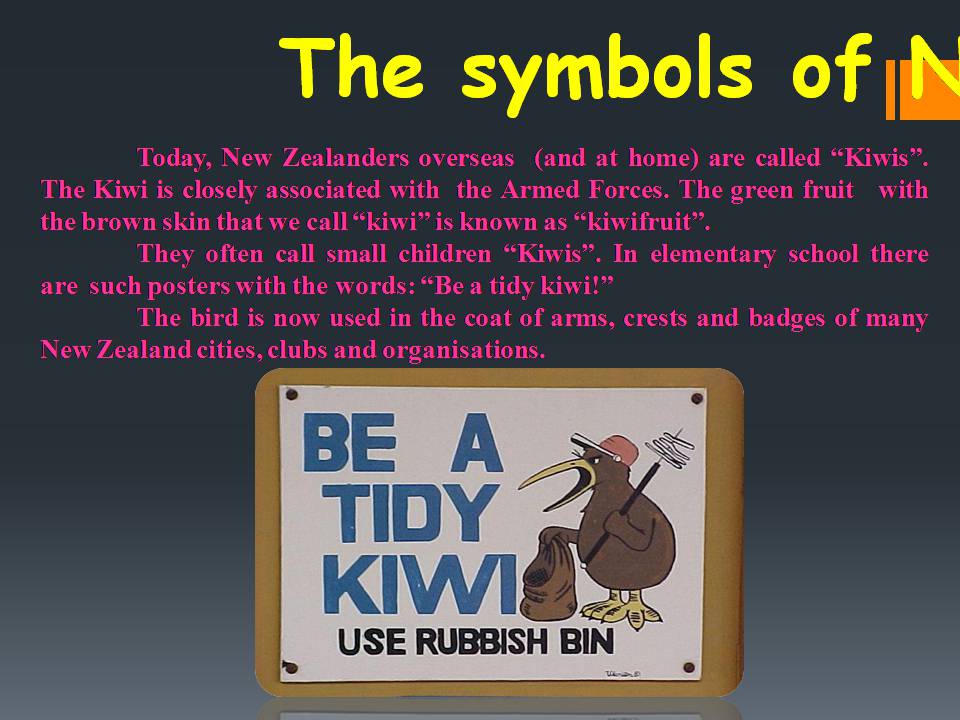
Слайд #22
The symbols of New Zealand
As for the New Zealand Flag, the stars of the Southern Cross show country's location in the South Pacific Ocean. The Union Flag shows that New Zealand was once a British colony.
As for the New Zealand Flag, the stars of the Southern Cross show country's location in the South Pacific Ocean. The Union Flag shows that New Zealand was once a British colony.
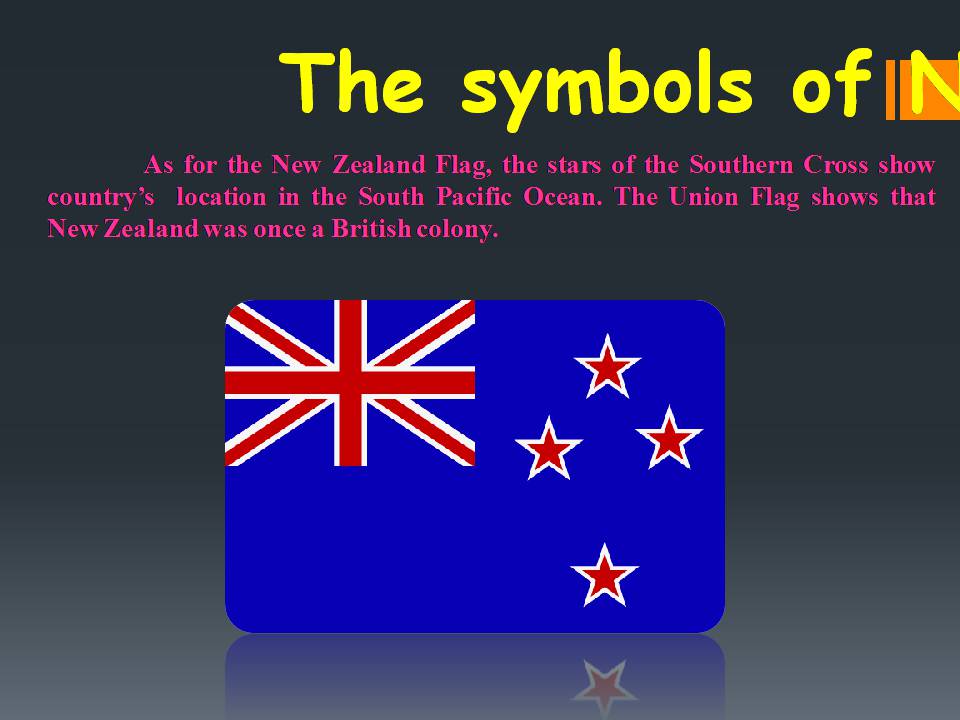
Слайд #23
The symbols of New Zealand
The New Zealand and Australian flags have very much in common. The only difference is that the Australian Flag shows the stars of the Southern Cross in white colour on a blue field while the New Zealand Flag shows the stars in red on a blue field.
The New Zealand and Australian flags have very much in common. The only difference is that the Australian Flag shows the stars of the Southern Cross in white colour on a blue field while the New Zealand Flag shows the stars in red on a blue field.
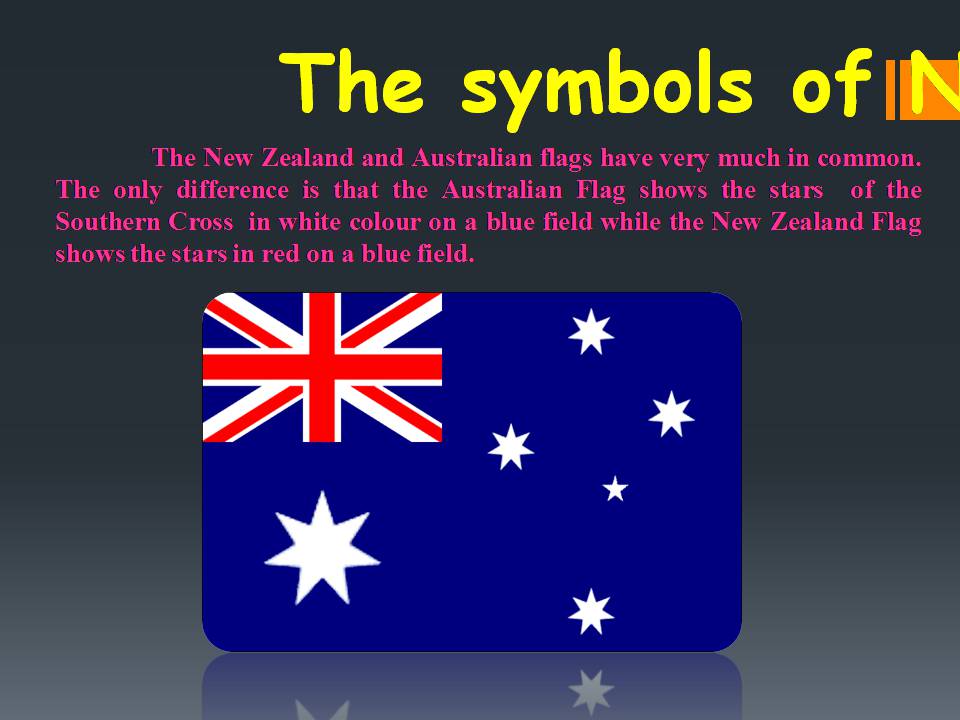
Слайд #24
The symbols of New Zealand
There are two national anthems of New Zealand and both have equal status. These are “God defend New Zealand” and “God Save the Queen”. The first one is always used on sports occasions.
New Zealand's coat of arms
There are two national anthems of New Zealand and both have equal status. These are “God defend New Zealand” and “God Save the Queen”. The first one is always used on sports occasions.
New Zealand's coat of arms
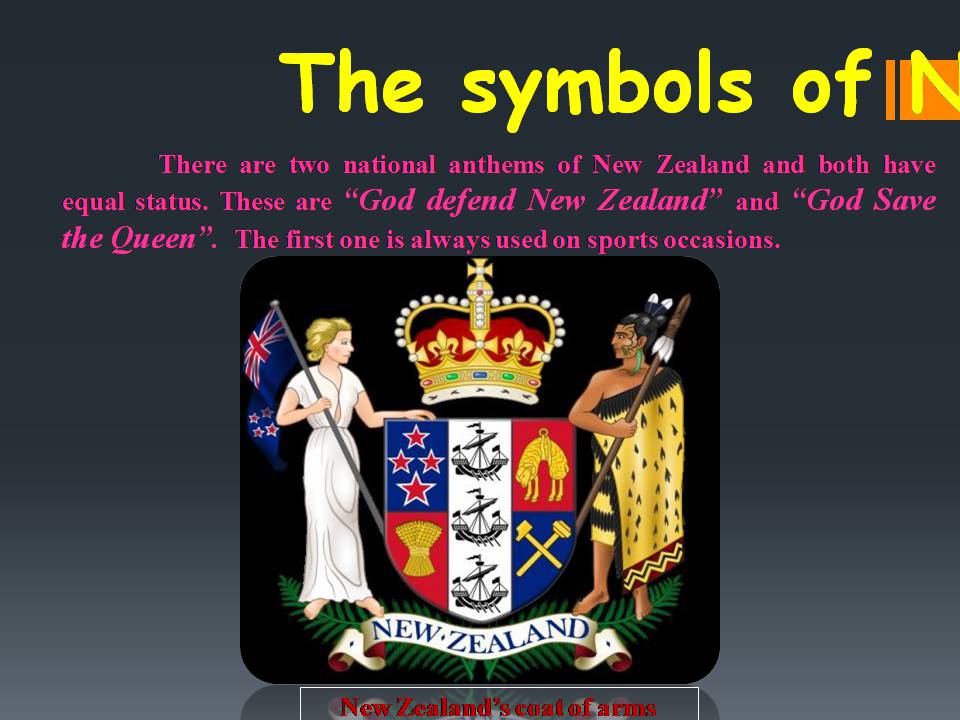
Слайд #25
The political system of New Zealand
New Zealand is an independent state and a member of the Commonwealth of Nations and the United Nations.
This country is a constitutional monarchy. The British monarch is the Head of State but Governor-General, usually a New Zealander, represents the Queen by carrying out responsibilities.
The government consists of the Governor-General, the Prime Minister who is the leader of the party in power, Cabinet (executive branch) and the Parliament (legislative branch).
John Key, the Prime Minister
New Zealand is an independent state and a member of the Commonwealth of Nations and the United Nations.
This country is a constitutional monarchy. The British monarch is the Head of State but Governor-General, usually a New Zealander, represents the Queen by carrying out responsibilities.
The government consists of the Governor-General, the Prime Minister who is the leader of the party in power, Cabinet (executive branch) and the Parliament (legislative branch).
John Key, the Prime Minister
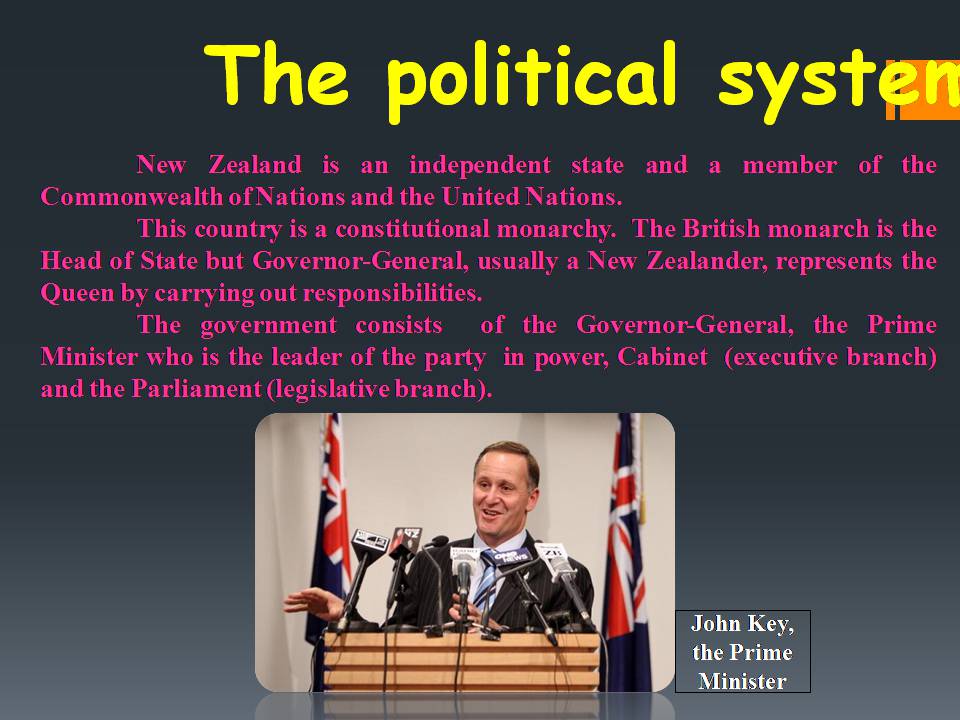
Слайд #26
The political system of New Zealand
The Parliament, contrary to the UK, consists of only one chamber – the House of Representatives. There are 120 members. Its members are elected every three years.
The chief political parties are the Labour Party, the National Party and the New Zealand First Party.
The Parliament, contrary to the UK, consists of only one chamber – the House of Representatives. There are 120 members. Its members are elected every three years.
The chief political parties are the Labour Party, the National Party and the New Zealand First Party.
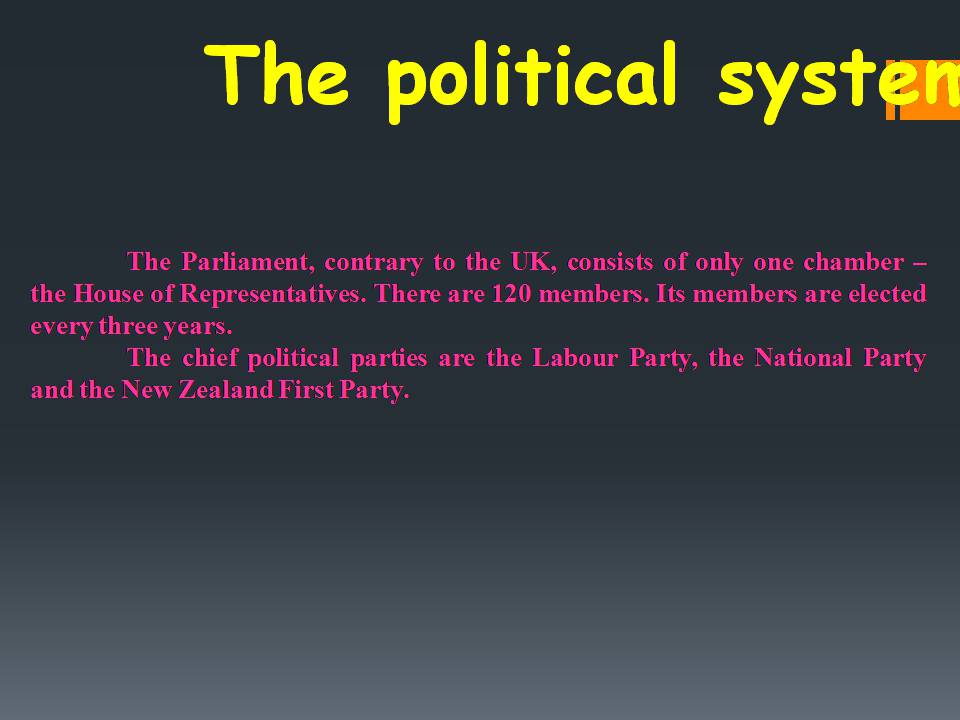
Слайд #27
Some details of culture of New Zealand
The culture of New Zealand is a mixture of different cultures: British, Aboriginal and other European countries.
Today New Zealanders are highly educated and sophisticated urban dwellers.
There is a cultural phenomenon in New Zealand known as “kiwiana”. You know that New Zealanders are called “kiwis” around the world after the native bird “kiwi”. Now their “kiwi” sense of humor, “kiwi” view of life make up “Kiwiana”, which is all the special things and details that show their national identity, their “kiwi nationhood”.
Kiwifruit, for example, was once known as Chinese gooseberry, but the fact that it was imported from New Zealand made world call this fruit – kiwifruit.
The culture of New Zealand is a mixture of different cultures: British, Aboriginal and other European countries.
Today New Zealanders are highly educated and sophisticated urban dwellers.
There is a cultural phenomenon in New Zealand known as “kiwiana”. You know that New Zealanders are called “kiwis” around the world after the native bird “kiwi”. Now their “kiwi” sense of humor, “kiwi” view of life make up “Kiwiana”, which is all the special things and details that show their national identity, their “kiwi nationhood”.
Kiwifruit, for example, was once known as Chinese gooseberry, but the fact that it was imported from New Zealand made world call this fruit – kiwifruit.
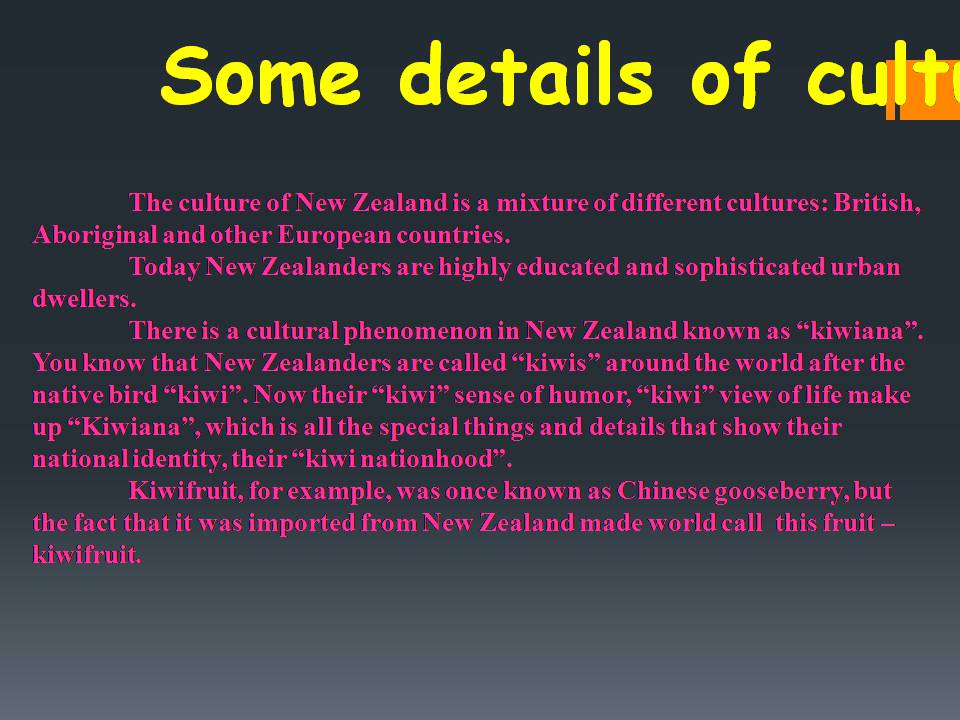
Слайд #28
Some details of culture of New Zealand
There is a famous New Zealand dessert called “pavlova” (meringue, cream and kiwi topping). It was invented as a tribute to the Russian ballerina Anna Pavlova who toured to Australia and New Zealand in 1926.
There is a famous New Zealand dessert called “pavlova” (meringue, cream and kiwi topping). It was invented as a tribute to the Russian ballerina Anna Pavlova who toured to Australia and New Zealand in 1926.
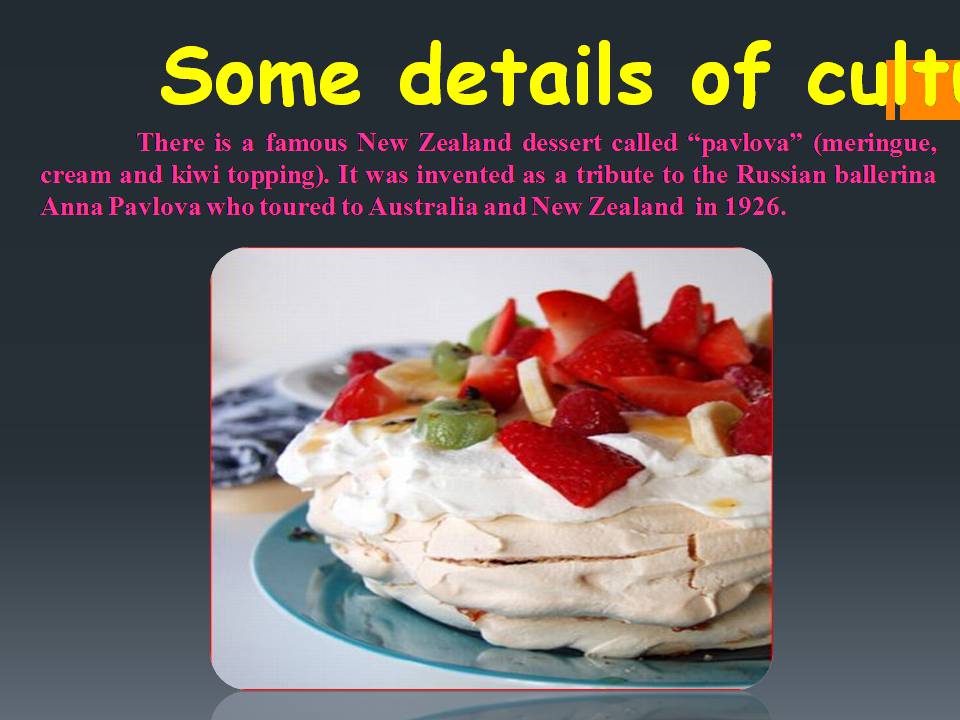
Слайд #29
Some details of culture of New Zealand
New Zealanders love water. They have a strong passion for ocean- going craft. New Zealanders have won many medals for yachting, windsurfing, kayaking and rowing.
New Zealanders love water. They have a strong passion for ocean- going craft. New Zealanders have won many medals for yachting, windsurfing, kayaking and rowing.
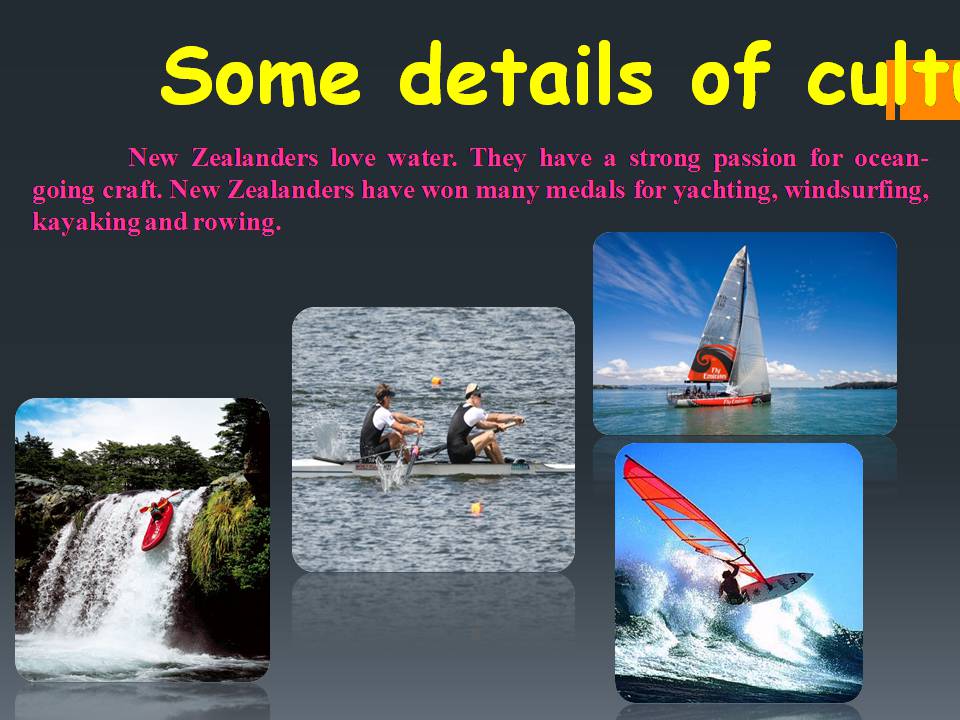
Слайд #30
Some details of culture of New Zealand
Among the qualities valued by New Zealanders are individualism, self-reliance and a genius for invention. Long time ago first people in New Zealand dealt with isolation and the elements, so that it developed their ingenuity and made them multi-skilled. That contributed a lot to their character.
They also have a strong sense of fair play and teamwork. New Zealand was one of the first countries who gave women the right to vote.
The language in this country is close to Australian English with some elements of the Maori language.
Among the qualities valued by New Zealanders are individualism, self-reliance and a genius for invention. Long time ago first people in New Zealand dealt with isolation and the elements, so that it developed their ingenuity and made them multi-skilled. That contributed a lot to their character.
They also have a strong sense of fair play and teamwork. New Zealand was one of the first countries who gave women the right to vote.
The language in this country is close to Australian English with some elements of the Maori language.
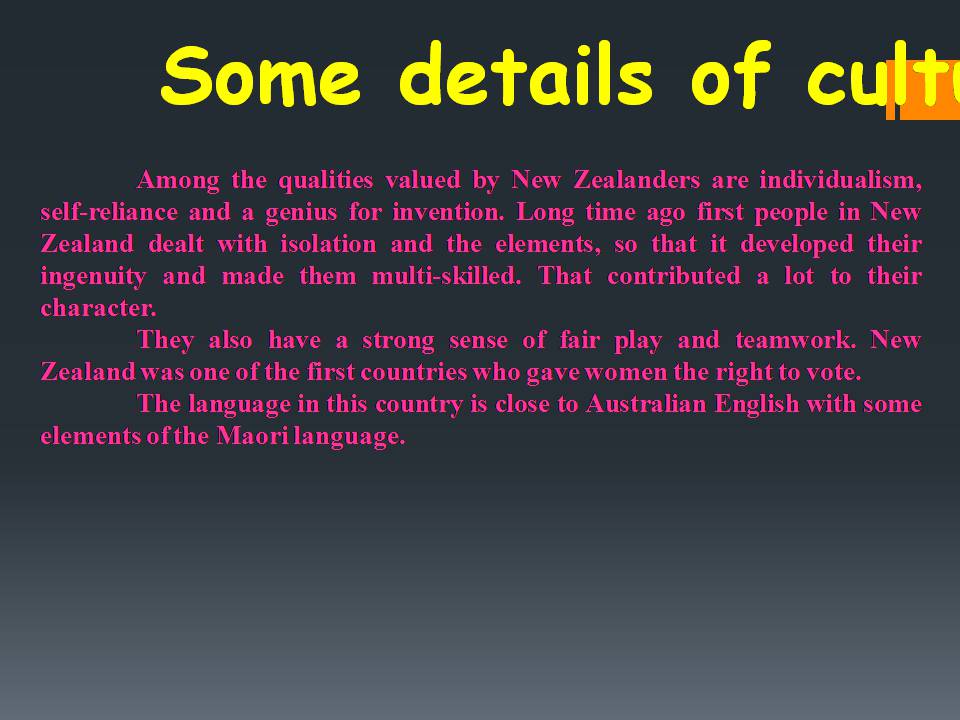
Слайд #31
Wellington
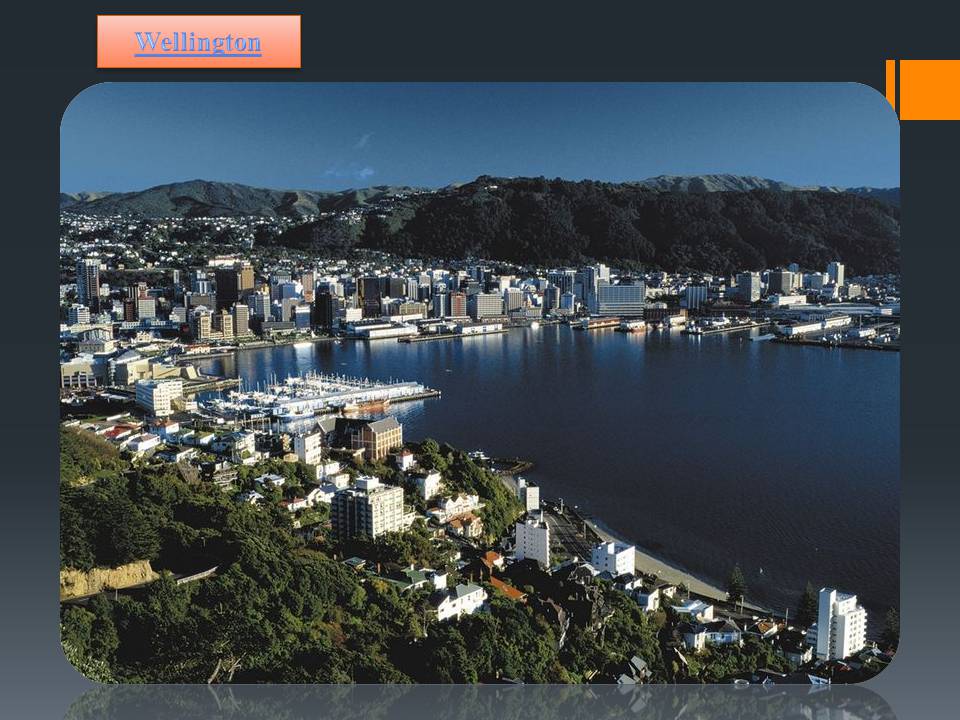
Слайд #32
Auckland
Christchurch
Dunedin
Christchurch
Dunedin
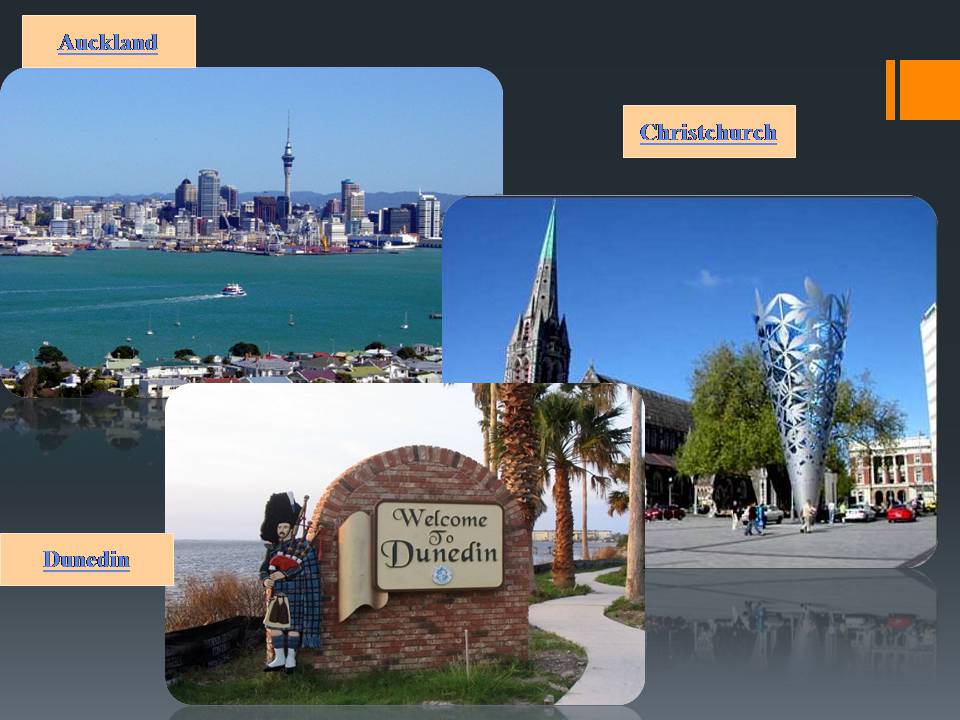
Слайд #33
The Tasman Sea
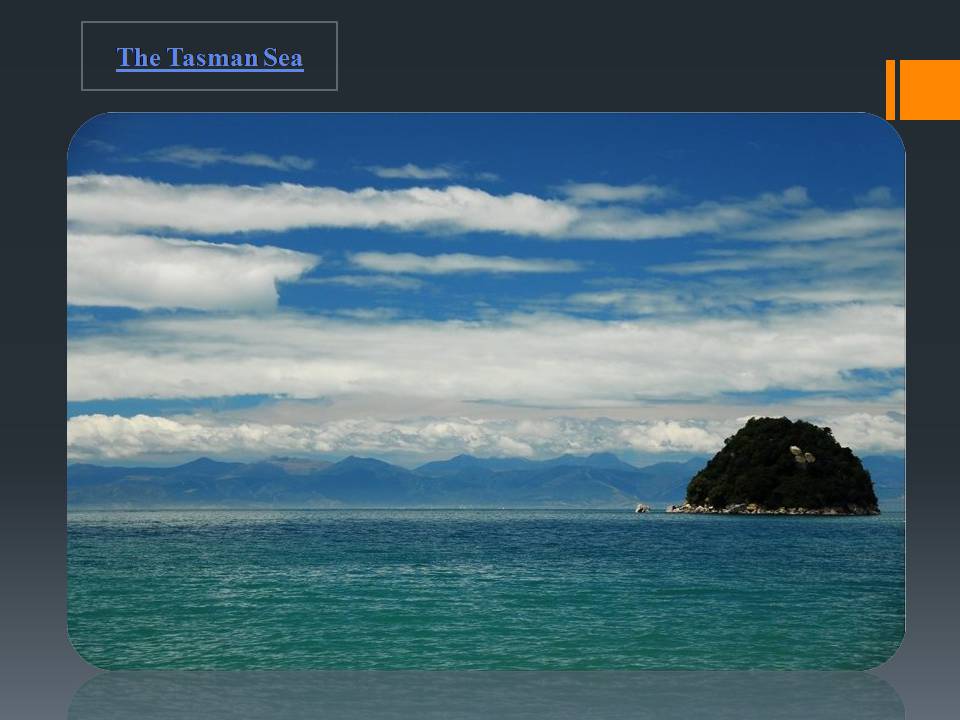
Слайд #34
Bungee jumping in New Zealand
